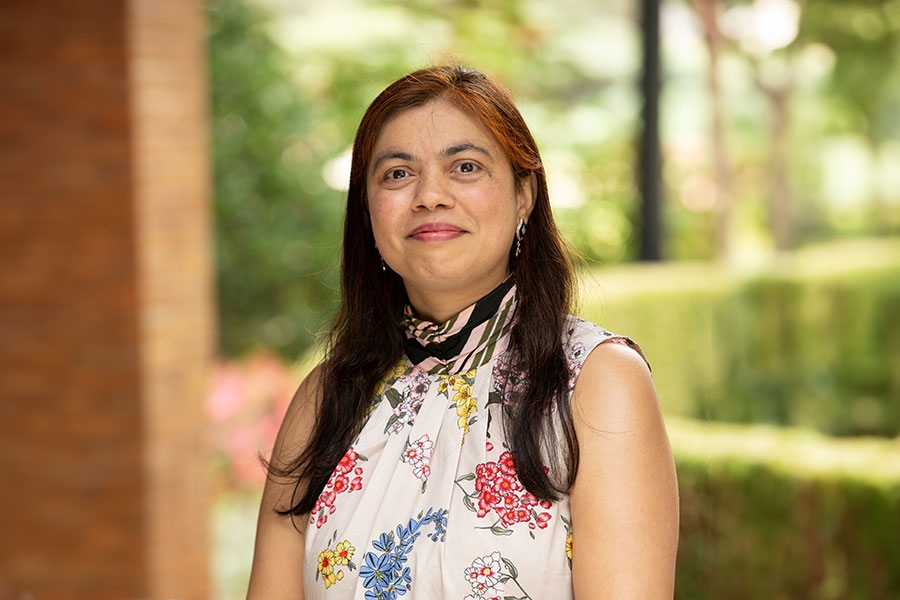
OKLAHOMA CITY – The chemotherapy drug cisplatin is a lifesaver for many adults and children diagnosed with cancer, but it often causes hearing loss, a side effect that can diminish quality of life following treatment. To prevent hearing damage during cancer treatment, a University of Oklahoma researcher created a novel drug delivery system that transports medications to the inner ear; her studies about the promising innovation are published in the Journal of Controlled Release and the Journal of Nanobiotechnology.
When a patient receives cisplatin, the drug quickly finds its way to the cochlea, the snail-shaped organ in the inner ear. The drug is retained for months in the cochlea, where it damages the tiny hair cells that play a critical role in the brain’s ability to interpret sound. Once the hair cells are damaged, they never regenerate, and hearing begins to wane. The effect is especially pronounced in children.
That reality spurred Vibhuti Agrahari, Ph.D., an assistant professor at the University of Oklahoma College of Pharmacy, to create a method of placing drugs in the ear, where they essentially stand guard as cisplatin approaches.
“To treat this type of hearing loss, we really wanted to focus on a prophylactic cure – giving the medications before the chemotherapy begins. We wanted to create a targeted drug delivery approach that can be given directly into the inner ear, rather than an oral drug that must travel throughout the body,” Agrahari said. “Hearing aids and cochlear implants are options, and doctors sometimes prescribe off-label drugs, but that is not solving the bigger problem of preventing the hearing loss. The problem is especially significant in young children being treated for cancer because they are undergoing so much learning and cognitive development.”
To create the drug delivery system, Agrahari and her research team carefully considered the route it would take to the inner ear and the obstacles it would encounter along the way. As a drug transporter, the delivery system is like a sophisticated vehicle with an excellent GPS: stable for the journey but nimble and crafty to make it past barriers. And it must carry drugs that can specifically address how cisplatin damages the process of hearing.
The “vehicle” portion of the system is comprised of hydrogels, which are water-based substances that can change structure based on their environment. The hydrogel begins as a liquid so that it can be given via an injection, but once it encounters the body’s temperature, it turns into a gel. The hydrogel is also compatible with the human body so the immune system won’t view it as an invader.
Within the hydrogel are nanoparticles, minute materials that actually carry the drugs. Each nanoparticle is about 100 nanometers wide; for perspective, a human hair is approximately 100,000 nanometers wide. The small size enables the nanoparticles to cross a membrane they encounter on the way to the cochlea. Once they reach their destination, the environment of the cochlea prompts the release of the drugs, and because the nanoparticles are within the hydrogel, they discharge slowly, like an extended-release drug. The gel also prevents the nanoparticles from sliding into the eustachian tube, the pipe-like structure near the cochlea.
Agrahari has studied several drugs in the delivery system. Some block calcium, which is known to damage the inner ear hair cells, and others are antioxidants, which protect the hair cells and maintain the delicate homeostasis of the inner ear. Using mathematical modeling software, Agrahari and her team chose several configurations of drug amounts and formulation sizes.
Agrahari tested the drug delivery system in her laboratory using inner ear cell lines. The approach is now being tested in animal models with her collaborators at Hough Ear Institute in Oklahoma City. Although the research is in its early stages, it has already shown positive results, both for the delivery system and the drugs’ ability to prevent the damage that leads to hearing loss. Patents have been filed to document the novelty and promise of Agrahari’s innovations.
“This is a small area of study that has a lot of potential,” Agrahari said. “Cisplatin is an important, lifesaving drug that we need for the treatment of cancer, but hearing loss affects quality of life, as well as the developmental process for children, up to 90% of whom face hearing loss after receiving this type of chemotherapy. It is important that we devise a solution that prevents the damage from ever occurring.”
About the project
The two studies are titled, “Cross-linked hybrid nanoparticle embedded in thermogel for sustained co-delivery to inner ear” (https://doi.org/10.1186/s12951-024-02686-z) and “Dual stimuli-responsive and sustained drug delivery NanoSensoGel formulation for prevention of cisplatin-induced ototoxicity” (https://doi.org/10.1016/j.jconrel.2024.02.005). The studies were supported by awards from the Presbyterian Health Foundation, Capita Foundation Auditory Research Grant and the OU College of Pharmacy.
About the University of Oklahoma
Founded in 1890, the University of Oklahoma is a public research university located in Norman, Oklahoma. As the state’s flagship university, OU serves the educational, cultural, economic and health care needs of the state, region and nation. OU was named the state’s highest-ranking university in U.S. News & World Report’s most recent Best Colleges list. For more information about the university, visit ou.edu.
Three University of Oklahoma graduate students have been named winners of the 2025 Three Minute Thesis competition, which challenges participants to explain their research in three minutes to a non-specialist audience.
Sarah Sharif, a researcher with the University of Oklahoma, has been awarded funding from the U.S. Department of Defense (DoD) to create innovative light detectors that pick up mid-wave and long-wave infrared signals at higher temperatures than previously considered achievable.
A team from OU and WVU recently earned a five-year, $3.5 million grant from the National Institutes of Health to study how concept cigarillos influence the potential for addiction. The results will be used to inform the FDA’s impending flavor ban on cigar products and could have wider-reaching implications for other tobacco products that come in flavors, such as e-cigarettes and tobacco-free nicotine pouches.